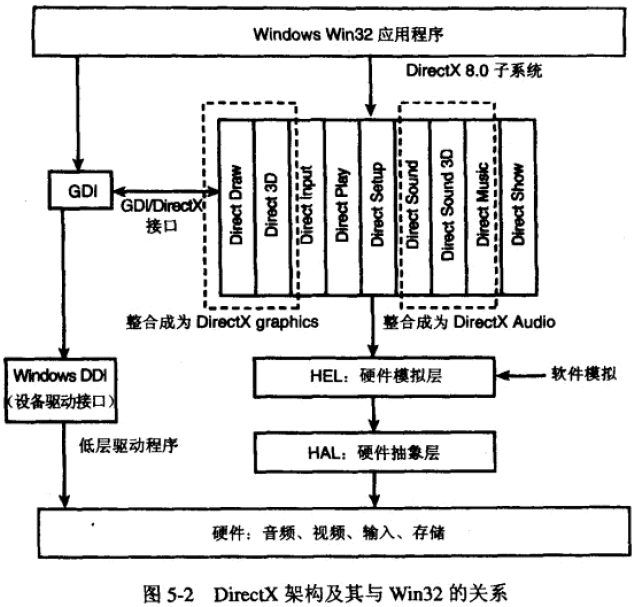《Windows游戏编程大师技巧》五、DirectX基础知识和令人生畏的COM
2012-04-29 21:40 java线程例子 阅读(479) 评论(0) 编辑 收藏 举报
所有的DirectX组件都是以COM实现的,两者环环相扣。
DirectX基础
DirectX可能会让身为程序员的你丧失些对硬件的控制能力,但是DirectX比Windows系统自带
的GDI或MCI快上很多倍,并且也更稳定。在编写Windows游戏的过程中,使用DirectX的方法
要干净和优雅得多。

你只要向DirectX发出命令,它就会帮你处理所有细节问题。无论是显卡、声卡、键盘鼠标
还是网卡,只要是DirectX支持的硬件,就可以被你的程序使用而无需知道其中的奥秘。
DirectX是如何工作的呢?通过COM技术,以及一套由微软和硬件厂商共同编写的驱动库就
可以实现。硬件商必须遵守微软的协议才能开发与硬件通信的驱动程序。
DirectX已经包含了许多组件,包括DirectDraw、DirectSound、DirectInput、DirectShow等等。

从上图中可以看到在DirectX 8.0版本里,DirectDraw和Direct3D合并为DirectX Graphics。而DirectSound和
DirectMusic合并为DirectX Audio。并且DirectShow也集成到DirectX里。虽然有很多版本,但我们可以通过
COM决定究竟使用DirectX 3.0、5.0、6.0或是其他版本。并且各版本只是有些许的差别,学会一个版本就
能够掌握其他的(除了Direct3D)。但本书不会太多涉及DirectX的内容,毕竟你的整个游戏编程生涯并不会
与DirectX绑在一起。当你以后使用其他API时仍然可以理解游戏编程的基础技术,这才是本书的终极目标。
从上图中还会发现,DirectX下有两个层叫做HEL(硬件仿真层)和HAL(硬件抽象层)。HAL直接和硬件对话,
是硬件商提供的设备驱动程序。当硬件支持你要求的功能时HAL才被使用,可以通过DirectX调用直接和它通信。
例如当你要求绘制一个位图时,硬件数据块复制器能迅速完成这个任务,比软件循环高效得多。HEL则是当硬件
不支持你要求的功能时被使用。比如当硬件不支持位图旋转时,HEL就会通过软件运算来完成该项任务。显然
这样处理速度会慢,但关键是这样不会因为硬件不支持而影响你的程序。另外,HAL和HEL之间的切换对用户而言
是透明的。
你能想象自行编写驱动程序来支持市场上所有显卡吗?这需要数千人年的工作量,事实上也是不可能完成的。
DirectX的确是微软和所有硬件商倾注了大量研究和努力的成果,它是超高性能的标准。
COM:是微软还是魔鬼的杰作?
虽然C++有许多很酷的OO功能,但很多人仍然不使用或者用错。因此大规模程序的
编写仍然是个问题,这也是COM模型要解决的困难之一。当修改或升级一部分代码时,
必须要重新编译生成一个可执行文件,这也是COM要解决的另一个问题。不用重新编译
程序就能升级COM模块,即插即用。这项技术在底层非常复杂,编写自己的COM对象也
非常有挑战性,但是COM对象使用起来却是非常容易的。
一个COM对象事实上就是一套实现了大量接口的C++类。这些接口用于和COM对象交互。
所有接口必须从一个名为IUnknown接口继承而来。
struct IUnknown
{
virtual HRESULT __stdcall QueryInterface(const IID &iid, (void**)ip);
virtual ULONG __stdcall AddRef() = 0;
virtual ULONG __stdcall Release() = 0;
}
QueryInterface根据一个128位的接口标识符iid来返回请求的接口。
AddRef和Release管理引用计数器跟踪当前COM对象生命周期。
COM的设计者只是使用虚C++类来实现COM,而不要求用户也必须使用C++来
访问或者创建它们。只要你创建的是一个和Microsoft C++编译器在创建虚C++
类时所创建的二进制映像一样的映像,这个COM对象就可以兼容。
来看一个可以运行的COM对象实例。
DirectX的COM对象有很多。这些COM对象在安装DirectX时作为动态链接库DLL
包含在你的系统中。当运行DirectX游戏时,程序会装载DLL,请求接口,然后
接口的实现函数会被调用从而完成任务。编译时,不需要调用CoCreateInstance
函数,也不需要对COM进行初始化,从而从操作COM的沉闷工作中解脱出来。
因此编译时要包含一些库函数.LIB文件,应用程序与DLL中COM对象的桥梁。
// DEMO5_1.CPP - A ultra minimal working COM example
// NOTE: not fully COM compliant
// INCLUDES //////////////////////////////////////////////////////////////////////////////////
#include <stdio.h>
#include <malloc.h>
#include <iostream>
#include <objbase.h> // note: you must include this header it contains important constants
// you must use in COM programs
using namespace std;
// GUIDS /////////////////////////////////////////////////////////////////////////////////////
// these were all generated with GUIDGEN.EXE
// {B9B8ACE1-CE14-11d0-AE58-444553540000}
const IID IID_IX =
{ 0xb9b8ace1, 0xce14, 0x11d0, { 0xae, 0x58, 0x44, 0x45, 0x53, 0x54, 0x0, 0x0 } };
// {B9B8ACE2-CE14-11d0-AE58-444553540000}
const IID IID_IY =
{ 0xb9b8ace2, 0xce14, 0x11d0, { 0xae, 0x58, 0x44, 0x45, 0x53, 0x54, 0x0, 0x0 } };
// {B9B8ACE3-CE14-11d0-AE58-444553540000}
const IID IID_IZ =
{ 0xb9b8ace3, 0xce14, 0x11d0, { 0xae, 0x58, 0x44, 0x45, 0x53, 0x54, 0x0, 0x0 } };
// INTERFACES ////////////////////////////////////////////////////////////////////////////////
// define the IX interface
interface IX: IUnknown
{
virtual void __stdcall fx(void)=0;
};
// define the IY interface
interface IY: IUnknown
{
virtual void __stdcall fy(void)=0;
};
// CLASSES AND COMPONENTS ///////////////////////////////////////////////////////////////////
// define the COM object
class CCOM_OBJECT : public IX,
public IY
{
public:
CCOM_OBJECT() : ref_count(0) {}
~CCOM_OBJECT() {}
private:
virtual HRESULT __stdcall QueryInterface(const IID &iid, void **iface);
virtual ULONG __stdcall AddRef();
virtual ULONG __stdcall Release();
virtual void __stdcall fx(void) {cout << "Function fx has been called." << endl; }
virtual void __stdcall fy(void) {cout << "Function fy has been called." << endl; }
int ref_count;
};
// CLASS METHODS ////////////////////////////////////////////////////////////////////////////
HRESULT __stdcall CCOM_OBJECT::QueryInterface(const IID &iid, void **iface)
{
// this function basically casts the this pointer or the Iunknown
// pointer into the interface requested, notice the comparison with
// the GUIDs generated and defined in the begining of the program
// requesting the IUnknown base interface
if (iid==IID_IUnknown)
{
cout << "Requesting IUnknown interface" << endl;
*iface = (IX*)this;
} // end if
// maybe IX?
if (iid==IID_IX)
{
cout << "Requesting IX interface" << endl;
*iface = (IX*)this;
} // end if
else // maybe IY
if (iid==IID_IY)
{
cout << "Requesting IY interface" << endl;
*iface = (IY*)this;
} // end if
else
{ // cant find it!
cout << "Requesting unknown interaface!" << endl;
*iface = NULL;
return(E_NOINTERFACE);
} // end else
// if everything went well cast pointer to IUnknown and call addref()
((IUnknown *)(*iface))->AddRef();
return(S_OK);
} // end QueryInterface
////////////////////////////////////////////////////////////////////////////////////////////////
ULONG __stdcall CCOM_OBJECT::AddRef()
{
// increments reference count
cout << "Adding a reference" << endl;
return(++ref_count);
} // end AddRef
///////////////////////////////////////////////////////////////////////////////////////////////
ULONG __stdcall CCOM_OBJECT::Release()
{
// decrements reference count
cout << "Deleting a reference" << endl;
if (--ref_count==0)
{
delete this;
return(0);
} // end if
else
return(ref_count);
} // end Release
///////////////////////////////////////////////////////////////////////////////////////////////
IUnknown *CoCreateInstance(void)
{
// this is a very basic implementation of CoCreateInstance()
// it creates an instance of the COM object, in this case
// I decided to start with a pointer to IX -- IY would have
// done just as well
IUnknown *comm_obj = (IX *)new(CCOM_OBJECT);
cout << "Creating Comm object" << endl;
// update reference count
comm_obj->AddRef();
return(comm_obj);
} // end CoCreateInstance
///////////////////////////////////////////////////////////////////////////////////////////////
void main(void)
{
// create the main COM object
IUnknown *punknown = CoCreateInstance();
// create two NULL pointers the the IX and IY interfaces
IX *pix=NULL;
IY *piy=NULL;
// from the original COM object query for interface IX
punknown->QueryInterface(IID_IX, (void **)&pix);
// try some of the methods of IX
pix->fx();
// release the interface
pix->Release();
// now query for the IY interface
punknown->QueryInterface(IID_IY, (void **)&piy);
// try some of the methods
piy->fy();
// release the interface
piy->Release();
// release the COM object itself
punknown->Release();
} // end main

